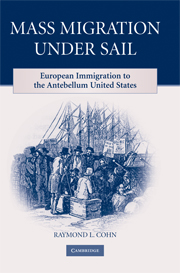Book contents
- Frontmatter
- Contents
- List of Tables and Figures
- Preface
- 1 A Unique Period for Immigration
- 2 The Onset and European Origins of Mass Immigration
- 3 The Jump in Immigrant Volume Around 1830
- 4 Push, Pull, and Other Factors in Antebellum Immigration
- 5 Who Were the Immigrants?
- 6 The Trip from Europe to the United States
- 7 The Immigrants in the United States
- 8 The Effects of Immigration on the United States
- 9 The End of Mass Migration Under Sail
- References
- Index
3 - The Jump in Immigrant Volume Around 1830
Published online by Cambridge University Press: 30 June 2009
- Frontmatter
- Contents
- List of Tables and Figures
- Preface
- 1 A Unique Period for Immigration
- 2 The Onset and European Origins of Mass Immigration
- 3 The Jump in Immigrant Volume Around 1830
- 4 Push, Pull, and Other Factors in Antebellum Immigration
- 5 Who Were the Immigrants?
- 6 The Trip from Europe to the United States
- 7 The Immigrants in the United States
- 8 The Effects of Immigration on the United States
- 9 The End of Mass Migration Under Sail
- References
- Index
Summary
One unique aspect of the antebellum period was the jump in the average annual volume of immigration, which Chapter 2 stated occurred around 1830. This chapter explains why the annual volume suddenly increased at this time, although a few of the supporting details are deferred to Chapter 4. The related issue of why the early immigrants came predominantly from southwest Germany and Ulster is also examined. Both issues involve sustained population growth throughout Europe, differential opportunities for individuals in different parts of Europe, changes in the shipping industry, and changes in the ability of individuals to immigrate. By 1830, these factors led to many more Europeans being willing and able to immigrate across the Atlantic Ocean. At about the same time, economic opportunities for the immigrants in the United States rose, an aspect of the story investigated in greater detail in Chapter 4. The result of all these factors was a substantial increase in the volume of immigration during the late 1820s and early 1830s.
The Theory of Immigration and the Rise in Volume
To understand why immigrant volume increased, it is first necessary to understand the motivation for why individuals immigrate. As mentioned in Chapter 1, economic factors were paramount by the antebellum period, with individuals moving to a situation they expected to be better. Thus, individuals or families compared their expected economic situation in the United States with their current one in Europe.
- Type
- Chapter
- Information
- Mass Migration under SailEuropean Immigration to the Antebellum United States, pp. 47 - 69Publisher: Cambridge University PressPrint publication year: 2008

